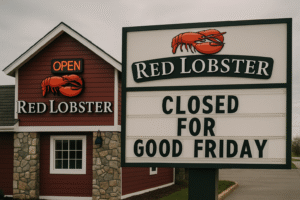
Red Lobster and TGI Friday Closing: What’s Behind the Shutdowns?
Meta Description:
Red Lobster and TGI Friday are closing locations across the U.S. and beyond. Discover the real reasons behind the closures and what it means for the restaurant industry.
Introduction: A Shocking Turn for Two Dining Giants
The casual dining world was shaken in 2025 by news of Red Lobster and TGI Friday closing dozens of locations nationwide. These iconic chains, once staples of family dinners and Friday nights out, are facing a wave of shutdowns that signal deeper shifts in consumer habits, real estate pressures, and the post-pandemic economy.
But what exactly led to this widespread retreat? Let’s explore the full story behind the closures and what it reveals about the future of sit-down restaurants.
The Scale of Closures: What’s Really Happening?
In the first half of 2025, Red Lobster quietly shuttered more than 90 of its underperforming locations across the United States. TGI Friday’s followed suit, announcing the closure of nearly 36 locations, with additional downsizing planned in select international markets.
These closures aren’t just isolated business decisions—they reflect a systemic issue affecting mid-tier dining chains: rising costs, declining foot traffic, and changing consumer behavior.
Red Lobster’s Struggles: Declining Sales & Financial Turmoil
Red Lobster, once the go-to destination for affordable seafood and unlimited shrimp deals, has seen its appeal wane over the last decade. According to recent financial reports:
-
The brand reported $11 million in losses in Q1 of 2025.
-
Its once-famous promotions, like the Endless Shrimp, began hurting more than helping due to rising food costs.
-
Labor shortages and higher operating costs added pressure, especially in suburban and small-town locations.
TGI Friday’s Challenges: A Brand Identity Crisis
TGI Friday’s, famous for its upbeat atmosphere, appetizers, and cocktails, is facing an identity crisis in the modern dining landscape.
-
Millennials and Gen Z consumers are less interested in traditional casual chains.
-
New competitors, like fast-casual and fusion eateries, offer more customizable and quicker meals.
-
Franchise issues have also led to inconsistent service and declining customer satisfaction across many locations.
Why These Closures Are Happening Now
While both chains have faced problems for years, a few major factors accelerated their closures in 2025:
1. Post-COVID Consumer Behavior
People are eating out less frequently at sit-down restaurants and preferring delivery, takeout, or fast-casual options. Red Lobster and TGI Friday’s have struggled to adapt to these evolving expectations.
2. Rising Labor & Food Costs
With inflation still affecting global supply chains, ingredient costs have soared. At the same time, the minimum wage has risen in several U.S. states, tightening profit margins even further.
3. Outdated Dining Models
The traditional dine-in experience offered by these chains hasn’t evolved quickly enough. Consumers are demanding more modern, healthier, and tech-savvy restaurant experiences.
Industry Reactions and Consumer Backlash
The closures sparked a wave of social media reactions, with many expressing nostalgia and disappointment. Customers shared stories of birthday dinners, date nights, and family celebrations at these restaurants.
However, the sentiment wasn’t entirely sentimental—many also acknowledged declining food quality, inconsistent service, and outdated decor as signs that the brands had fallen behind.
Is This the End of Red Lobster and TGI Friday?
Not entirely. While many locations are closing, both companies are restructuring, not disappearing.
-
Red Lobster is focusing on optimizing high-performing urban locations and enhancing its online ordering systems.
-
TGI Friday’s has hinted at a rebrand, experimenting with smaller, modernized layouts and more contemporary menus in select test markets.
To stay updated on tech, business trends, and industry shifts like these, check out TechGarcon — a hub for smart insights on what’s next in dining, tech, and beyond.
What This Means for the Restaurant Industry
The closing of Red Lobster and TGI Friday locations is not an isolated event. It highlights several broader themes:
● A Shift Toward Experience-Driven Dining
Restaurants that offer immersive experiences, personalization, and strong social media presence are winning over younger demographics.
● The Rise of Ghost Kitchens and Delivery-First Models
Chains that adapt to delivery apps, ghost kitchens, and mobile ordering are thriving. Those stuck in a dine-in-only model are falling behind.
● Real Estate Overhead Is Unsustainable
Large dining spaces in expensive urban areas no longer make financial sense unless they’re generating very high foot traffic.
Looking Ahead: Can Legacy Chains Survive?
The future for Red Lobster and TGI Friday’s—and other classic American dining chains—depends on innovation, agility, and understanding their evolving customer base.
Here’s what could save them:
-
Menu Modernization: Introducing healthier, locally sourced options
-
Tech Integration: Tabletop ordering, app loyalty programs, QR menus
-
Ambience Overhaul: Updating interiors to match modern aesthetics and expectations
Final Thoughts: A Cautionary Tale for the Industry
The wave of Red Lobster and TGI Friday closing news should serve as a wake-up call. In a rapidly changing world, even the most recognizable brands can lose relevance if they don’t evolve.
Restaurants must now balance tradition with innovation, nostalgia with novelty—and most importantly, must listen to their customers.
If you’d like more insights on this topic, tech trends, and the future of business, don’t miss out on the latest from Mind Sorrel.com

